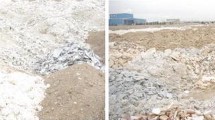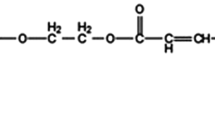Abstract
The aim of this study is to present the advantages of artificial stone production from the sludge of stone cutting factories (SSCFs), which is a self-cleaning and low-cost process, in Lorestan province, Iran. The basic formulation of artificial stone is the sludge stone: 50 % of the weight (wt.%) of sludge stone is cement. 12 wt.%, 25 wt.%, and 7 wt.% of the cement consists of unsaturated polyester resin liquid (UPR), water, and, filler respectively. The filler itself is made up of micro-silica and different amounts of anatase TiO2-NP and ZnO-NP. Nanoparticles lead to hydrophobicity, the analysis of oil stains, the elimination of bad odor, the sterilization and self-cleaning of artificial stone. The production of artificial stone via this method is pressure-resistant, highly flexible, resistant to freezing and scrapes, lightweight, capable of being cut and formed with a low thickness, and self-cleaning compared to the natural stone.
Similar content being viewed by others
References
Turgut P, Algin HM (2007) Limestone dust and wood sawdust as brick material. Build Environ 42 (9):3399–3406
Alzboon KK, Mahasneh KN (2009) Effect of using stone cutting waste on the compression strength and slump characteristics of concrete. Int J Environ Chem Ecol Geol Geophys Eng 3(3):460–465
Masoud T (2015) Effect of using stone cutting slurry waste (Al-Khamkha) on the compaction characteristics of Jerash cohesive soil. Open J Civ Eng 5:214–219
Fahiminia M, Ardani R, Hashemi S, Alizadeh M (2013) Wastewater treatment of stone cutting industries by coagulation. Process Arch Hyg Sci 2(1):16–22
Al-Zboon K, Tahat M, Abu-Hamatteh ZS, Al-Harahsheh MS (2010) Recycling of stone cutting sludge in formulations of bricks and terrazzo tiles. Waste Manag Res 28(6):568–74
Sabah E, Aciksoz C (2012) Flocculation performanve of fine particles in travertine slime suspension. Physicochem Probl Miner Process 48(2):555–566
Mashaly AO, Shalaby BN, El-Hefnawi MA (2012) Characterization of the marble sludge of the Shaq El Thoaban industrial zone, egypt and its compatibility for various recycling applications. Aust J Basic Appl Sci 6 (3):153–161
Joshi R (2013) Effect of using selected industrial waste on compressive and flexural strength of concrete. Int J Civ Struct Eng 4(2):116–124
Rehman W, Riaz M, Ishaq M, Faisal M (2014) Utilization of marble waste slurry in the preparation of bricks. J Pak Inst Chem Eng 42(1):2014
Al-Hamaiedh H (2010) Reuse of marble sludge slime in ceramic industry. Jordan J Civ Eng 4(3):264–271
Allam ME, Bakhoum ES, Garas GL (2014) Re-use of granite sludge in producing green concrete. ARPN J Eng Appl Sci 9(12):2731–2737
Al-Joulani N, Salah N (2014) The stone slurry in palestine from environmental burden to economic opportunities-feasibility analysis. J Environ Prot 5:1075–1090
Lea FM (1970) The chemistry of cement and concrete. Arnold, London
ACI COMMITTEE 211.1-91
Madandoust R, Alizadeh AM (2015) Assessing the effective parameters on normal strength concrete by core testing. J Automot Appl Mech 3(2):1–6
BS EN 14617-2: 2008, Agglomerated stone - Test methods - Part 2: Determination of flexural strength (bending)
EN 12372: 2007, Natural stone test methods - Determination of flexural strength under concentrated load
EN 14618: 2009, Agglomerated stone- Terminology and classification
EN 14617-16, Agglomerated stone - Test methods - Determination of dimensions, geometric characteristics and surface quality of modular tiles
BS EN 14617-1: 2005, Agglomerated stone - Test methods - Part 1: Determination of Apparent Density and Water Absorption
BS EN 14617-4: 2012, Agglomerated stone - Test methods - Part 4: Determination of the abrasion resistance
ISO 8486-1: 1996, Bonded abrasives - Determination and designation of grain size distribution - Part 1: Macrogrits F4 to F220
BS EN 16140: 2011, Natural stone test methods. Determination of sensitivity to changes in appearance produced by thermal cycles
Author information
Authors and Affiliations
Corresponding author
Rights and permissions
About this article
Cite this article
Sarami, N., Mahdavian, L. Mechanical Properties of Artificial Stones Produced from Sludge of Stone-Cutting Factories (SSCF): The Effects of Nano-fillers (aTiO2 and ZnO Nanoparticles). Silicon 9, 165–172 (2017). https://doi.org/10.1007/s12633-015-9386-4
Received:
Accepted:
Published:
Issue Date:
DOI: https://doi.org/10.1007/s12633-015-9386-4




